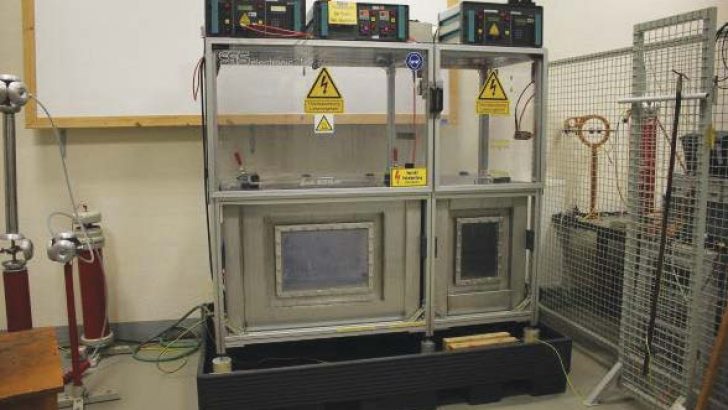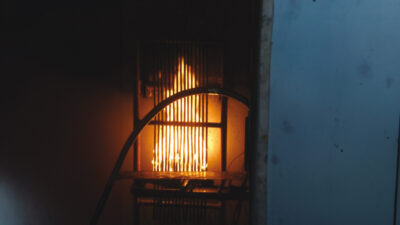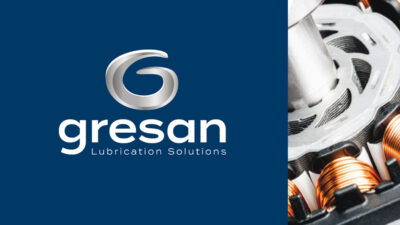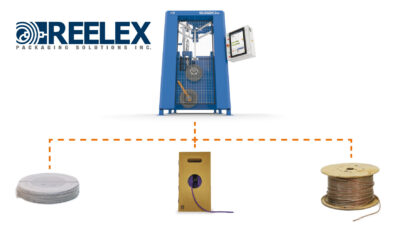LAPP The DC voltage revolution has begun


Industrial drives are among the largest consumers of electric power. By switching to DC power supply, enormous savings could be achieved. Industry, research and standardisation bodies are already working on the energy supply of the future. Questions still remain unanswered, for example: Are AC cables also suitable for direct current without further ado? LAPP is investigating this question in research projects.
Artificial intelligence and the new 5G mobile radio standard are probably the topics that attract the most attention at industry events around the world right now. But there is another topic that may turn out to have similarly profound implications: the swith of energy supply to direct current (DC). At Hannover Messe 2019, for example, there was talk of this at many stands and LAPP even showed its first finished products in its futureLab. The world market leader for integrated cable and connection systems is an associated partner in the DC Industry research project, which is funded under the 6th Energy Research Programme of the Federal Ministry of Economics and Energy. The research project deals with the question of how DC grids with central conversion can be established as an energy-saving alternative, especially for power units in production, and how regenerative energies can be better integrated. LAPP takes part in order to investigate the suitability of certain cable types and to develop cables suitable for DC networking.
First products from LAPP
The first product to emerge directly from the project is the ÖLFLEX DC 100, which LAPP presented at SPS 2018. The control cable is based on the well-known ÖLFLEX CLASSIC 100 for alternating current. However, the colour coding of the cores follows the standard DIN EN 60445 (VDE 0197):2018-02 for DC cables, updated in February 2018: red, white and green-yellow. The insulation of the cores is made of special PVC, the jacket is made of PVC. New products shown at Hannover Messe 2019 were: ÖLFLEX DC SERVO 700, a DC connection cable with special PVC insulation for supplying electrical drives, which is designed for occasional flexible use as well as for fixed installation. ÖLFLEX DC CHAIN 800 goes one step further. Based on current research results, the cable was equipped with TPE insulation and is therefore particularly suitable for continuous movement in energy guiding chains and in linearly moving machine parts. LAPP has also developed the ÖLFLEX DC 100 Hybrid, a cable for the DC industry consortium. The DC hybrid cable contains two cores for power transmission plus a protective conductor, a Cat.6A data cable with four shielded core pairs, two cores for safe torque off (emergency stop) and a control pair with 24 volts for the brake.
Huge savings potential
The partners in the DC Industry Consortium agree: DC power supply is essential if the energy revolution is to be truly successful. This is because it is not just a matter of generating the largest possible quantities of renewable energies such as solar and wind power. Considerable, but often overlooked, potential for conversion to a sustainable energy supply also lies in saving energy. Industry is in particular demand here. 48 per cent of net electricity in Germany – around 250 terawatt hours per year – is consumed by industry. Almost 70 per cent of this is from electric drives. This makes them the biggest lever for saving energy. With direct current supply, energy savings of up to 30 per cent could be achieved in production. The use of direct current would not only make conversion losses superfluous, but would also lead to more energy being fed into the grid when machines are braking. Electronic speed control offers further savings potential because many engines run at full speed, although this would not even be necessary. But the frequency inverters for speed control also waste energy, because they operate with DC voltage, which must be generated by rectifying AC voltage. This leads to conversion losses and backlashes on the grid due to harmonics, which make the grid unstable.
A supply of direct current would also be the ideal prerequisite for power units to be able to feed energy back into the DC grid during braking. As with electric or hybrid cars, this energy would be stored temporarily in order to be used again for subsequent accelerations. Or this energy could be used to supply consumers with high power requirements, for example during welding. Companies could thus cut peak loads and would not have to obtain large amounts of energy from the grid for a short time, which reduces costs and also reduces the load on the grid.
Not only industry, but also households would benefit. Many electrical consumers, from LED lights to industrial drives to electric cars, actually consume direct current, which at this point has to be converted from alternating current (AC) from the socket. In addition, more and more systems that generate direct current, above all photovoltaics, are feeding electricity into the increasingly decentralised power grid.
The energy system of the future The energy supply of the future could therefore look quite different than it does today:
– Energy generation: So far, alternating current power generation has been used, for example, in the generators of large coal-fired and nuclear power plants, but also in water turbines. Transformers can be used to increase the voltage to several 100,000 volts, which keeps the currents in the cables and thus the losses low.
– Energy distribution: The power grid has long been dominated by large power plants that distribute their energy in the form of stars to the surrounding regions. But with the triumph of renewable energies, the power grid is becoming more decentralized, more small-scale, and increasingly, electricity is consumed where it is generated. AC technology cannot play off its advantages there. But even over long distances, alternating current is not ideal.
Transmission losses are increasing significantly. For this reason, China, for example, is building complex networks with high-voltage direct current (HVDC) transmission, which transport large amounts of energy from the hydroelectric power plants in the interior of the country to the conurbations on the coasts. In Germany, too, the German government is planning such routes, which are to carry excess wind energy from the coasts to the south. An HVDC connection – although twice as expensive to build – is worthwhile from a length of about 400 kilometres thanks to the lower energy losses, and from 60 kilometres in the case of submarine cables for connecting offshore wind farms. HVDC connections are now very reliable. Progress in energy conversion through power electronics has enabled DC voltages to be converted to over one million volts. – Energy consumption: At home or in factories, electricity is distributed via low-voltage networks, either via earthed sockets or via three-phase connections. Computers and other electronic devices or LED lamps work with direct current and currently require a power supply unit for conversion. Electric cars will be added in the next few years. In industrial power units, frequency inverters with a DC intermediate circuit are increasingly being used for speed control. DC networks with central voltage conversion would make these many converters superfluous. There are already pilot projects in the automotive industry to supply entire production units with direct current only; they also contain batteries for short-term energy storage.
More and more losses
The most convincing argument for switching from AC to DC is efficiency. In the past, when coal-fired and nuclear power plants fed alternating current into the grid and vacuum cleaners and light bulbs used it directly, the overall efficiency of supplying electrical energy in Germany was around 65 per cent. In other words, about one third of the electrical energy was lost, for example due to heat losses. Today, the situation is getting worse and worse, because photovoltaic systems and power plants and the increasing installation of battery storage systems are bringing more and more electricity into the grid, which first has to be converted from direct to alternating voltage. This results in losses. The same applies to consumers: power supply units become hot – tangible proof that energy is wasted. As a result, the efficiency of the German energy network has fallen to an estimated 56 per cent – and will continue to do so unless fundamental changes are made. An energy grid consistently designed for direct current would achieve an overall efficiency of 90 per cent. Even if “only” the drives in industry were switched to DC, that would mean a power savings of 30 per cent per factory, and ten per cent nation wide in Germany.
Many open questions
While high-voltage direct current transmission has been proven and established, a number of technical and economic issues remain to be resolved on the low-voltage side. Will direct current networks replace alternating current on a broad front? Will both technologies continue to exist in parallel and what might coexistence look like? What technical and economic hurdles need to be overcome? Which safety measures are necessary and sensible when dealing with direct current? What changes would be necessary when switching to direct current not only in the networks but also in the consumers including the installation?
A question that has not yet been discussed: Are cables designed for AC also suitable for DC? There have been no research results on this so far. Long-term tests conducted by Prof. Frank Berger’s research group in the field of “Electrical Devices and Systems” at the Technical University of Ilmenau now prove for the first time that indeed there are significant differences. Over a period of 2,590 hours, Berger’s team loaded single conductors with various insulation materials in a water bath at 80 °C with 1 kV DC voltage in order to understand the effects in fast motion. The test equipment and the lines were provided by LAPP.
Surprising ageing tests
The results are intriguing. Of the 238 test specimens, 44 per cent failed under DC load, while only one specimen failed under AC load. Cables with PVC insulation were particularly affected, with all test specimens failing. The failure rate for insulation with polyolefin was also high, while cables with TPE insulation mastered the test very well. Based on these test results, the ÖLFLEX DC CHAIN 800 was equipped with TPE insulation to ensure high performance. One third of the defects were caused by insulation faults. This is the case if the insulation resistance falls below a critical value of 10 MΩ. Two thirds of the defects resulted in visible, physical punctures of the insulation.
The failures occurred much earlier with cables that were additionally subjected to mechanical stress due to narrow bending radii. New cables withstood approximately the same voltages before the start of aging, regardless of whether DC or AC voltage was used. It was the aging process that caused the cables to fall behind with DC loading. The wall thickness of the insulation also played no decisive role in the frequency and timing of the failures.
Expert opinion disproved
The research results are an important indication that the electric field generated by the DC voltage has a different effect on the ageing behaviour of insulation materials than an AC voltage field. Many experts had disputed this so far. In a classical AC cable, the electric field strength is highest directly at the surface of the copper conductor and decreases with the radius to the outside. The same is true even at high temperatures, because the dielectric constant is almost independent of the temperature. On the other hand, the electrical field strength of DC cables is determined by the electrical conductivity of the insulating material. If the conductivity of the insulation increases with increasing temperature, the electric field decreases only slightly with the radius to the outside, and at high temperatures even field inversion can occur: The electric field strength is higher on the outside of the insulation than on the inside of the conductor.
Only single conductors tested
In order to rule out any mutual influence of individual conductors and sheath in the course of the investigations, the laboratory tests were initially carried out on individual conductors in the water. Only their insulation strength was tested. This does not correspond to the operating conditions in practice, as there are usually several cores in one cable which are bundled in a sheath. However, Prof. Berger’s team is aiming for measurements on complete cables in the future. The visual phenomena also raise questions about the suitability of the test method used. The method of accelerating ageing in a water bath complies with the requirements of DIN VDE 0276-605 and has proven itself with AC voltage lines. It also provides good indications of the actual ageing behaviour over long periods of years and decades. This also applies to PVC cables. However, it is questionable whether this also applies to operation with DC voltage. Here the water seems to play a different, unforeseen role; it obviously accelerates the time-lapse once again considerably.
Further research needed
In order to arrive at reliable statements here, further research is needed. On the one hand, Prof. Berger is planning ageing tests that do not require a water bath, but which would then have to take longer. On the other hand, he wants to understand what happens chemically and physically in plastics when the above-mentioned reversal of the electric field occurs. The degradation of the polymer or swelling in the water as well as the dissolution of additives or the formation of “water trees” could be possible causes. Until reliable data are available, there is no reason not to use PVC insulated cables in static DC applications. The prerequisite, however, is that these cables are laid firmly, i.e. without movement, and without mechanical stress due to bending radii that are too narrow. In addition, the environment should always be dry. If these conditions are not met, for example in moving applications in energy chains, users can switch to other insulation materials. TPE, for example, scored excellently in the water bath tests.






